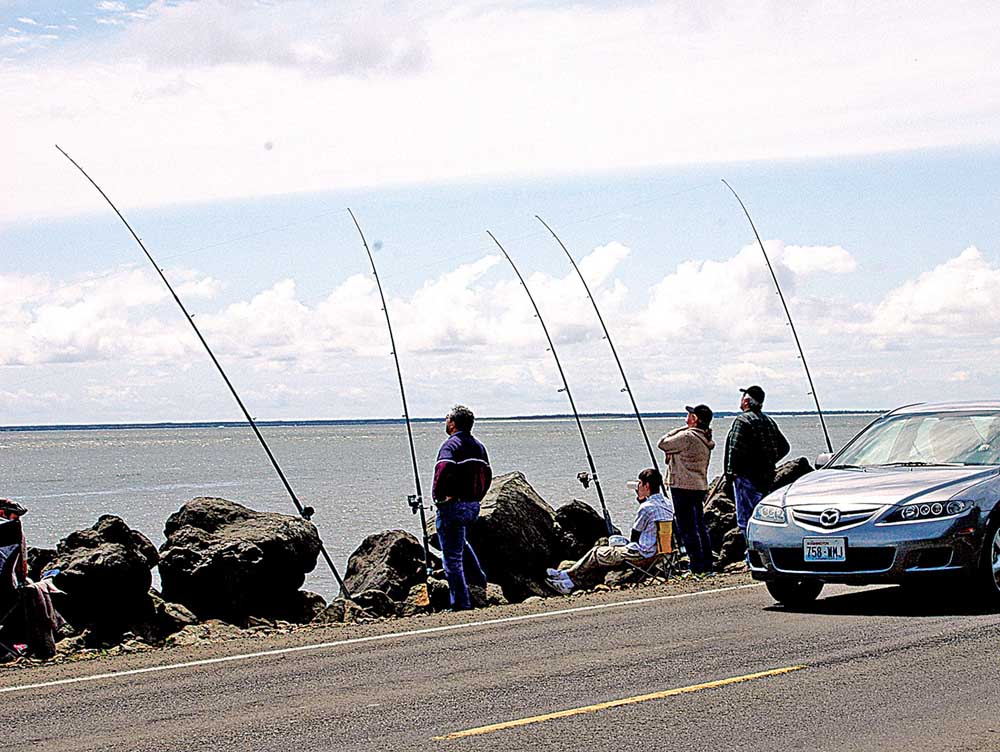Sturgeon numbers continue to grow, but states worry about productivity
Published 8:43 am Tuesday, March 8, 2016

- Hundreds of sturgeon fishermen and women once stood shoulder to shoulder between the Chinook Tunnel and the Astoria-Megler Bridge. In 2014, the states of Washington and Oregon declared a harvest moratorium, ending this tradition for the time being.
The overall number of white sturgeon that are of legal size (38 inches to 54 inches long) in the Lower Columbia River continues to grow.
Trending
After a low of 72,200 fish in 2012, the population grew to 143,900 fish in 2015 and is expected to grow to 147,100 legal-sized fish this year.
That’s the good news.
However, there are still low numbers of spawning adult fish, annual natural production of up to one-year-old sturgeon continues to be poor and there are reduced numbers of juvenile fish smaller than legal size.
Trending
These signs point to “ongoing productivity issues,” according to an update before the Oregon Fish and Wildlife Commission, Feb. 9, by Tucker Jones, manager of the Oregon Department of Fish and Wildlife’s Ocean Salmon and Columbia River Program.
With just an estimated 3,000 spawner-sized adult sturgeon, and a three-year (2013 to 2015) average of 3,300, the adult population remains below the conservation status of 3,900 fish specified in the Lower Columbia River and Oregon Coast White Sturgeon Conservation Plan, according to updates given before the Washington and Oregon fish and wildlife commissions at their meetings in January and February.
According to the update, the plan sets long-term management goals for white sturgeon, including abundance levels for adults and sub-adults (which include legal-sized fish) that constitute a “healthy and harvestable population.”
The plan capped long-term harvest at 16 percent, a level that was adopted by both Washington and Oregon in 2012 (both states cooperatively manage white sturgeon in the Columbia River).
However, the number of legal-sized white sturgeon continued to decline, and in 2014 both states declared a moratorium on commercial and recreational fishing for the sturgeon in the lower Columbia River (the river downstream of Bonneville Dam and in the Willamette River up to Willamette Falls), but the states continue to allow catch-and-release fishing.
Neither commission ruled that catch-and-release should stop, but the Washington Commission directed its fish and wildlife staff to consult with the ODFW staff about closing catch-and-release fishing for white sturgeon.
“I don’t think we need to do that,” Jones said. “While the sturgeon population is not where we’d like to see it, this is not a population that is in danger. We’ve already taken pretty serious actions in response to some of the things that have been happening with sturgeon. We’re already erring on the side of protecting these fish.”
Tucker said that the commission was comfortable with ODFW staff’s recommendation not to change “the current structure of the lower Columbia River white sturgeon fisheries.”
That recommendation, he said, was based on several factors, including the large number of fish in the population that are over 21 inches in length, the stable, although low, adult numbers over the past five years, the action already taken to suspend the fisheries and having a conservation plan in place that provides a management framework.
In addition, after the moratorium began and the fishery changed to catch-and-release only, the number of angler trips declined by over 90 percent. In 2013, the last year that harvest was allowed, anglers made 33,094 trips to fish for white sturgeon. That dropped to 3,120 in 2014 and 3,004 in 2015.
Prior to the harvest moratorium in 2014, harvest guidelines were relatively high. With an estimated legal-sized population of 101,200 fish in 2008, a harvest of 40,000 fish was allowed, and in 2009 the population dropped to 95,000 fish, but the harvest guideline remained the same.
In 2010, the method of estimating the number of fish changed. So, the 2010 legal-sized population was estimated at 65,300 (historic method) and 100,200 (setline method) and harvest was set at 24,000 fish; in 2011 with the number of fish estimated to be 72,800 (80,500), allowed harvest was set at 17,000 fish; and in 2012, the number was 83,400 (72,700) and harvest was set at 10,400.
Using only the setline method of estimation, the number was 114,200 fish in 2013, with an allowed harvest of 10,105 fish. That was the last year harvest was allowed.
Once harvest of the fish ceased, the estimated population of legal-sized fish began to grow to 130,990 in 2014 and 143,840 in 2015.
Predation by pinnipeds continues to be a problem, except at Bonneville Dam where the number of white sturgeon taken by sea lions has declined, even while the number of sea lions present at the dam has increased, according to WDFW information.
“Steller sea lion predation of white sturgeon began around the mid-2000’s in the gorge below Bonneville Dam. Numbers of Steller sea lions present in the tailrace immediately below the dam peaked in 2010 and again in 2015,” according to the WDFW summary. “Observed consumption of white sturgeon at Bonneville Dam during the past four years has decreased annually, to less than 5 percent of the peak level reached in 2011, indicating few sturgeon remain in the area when sea lions are present.”









